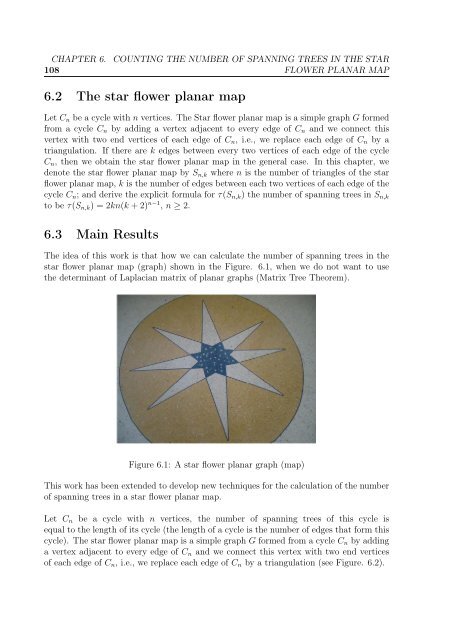enumeration of the number of spanning trees in some ... - Toubkal
enumeration of the number of spanning trees in some ... - Toubkal
enumeration of the number of spanning trees in some ... - Toubkal
Create successful ePaper yourself
Turn your PDF publications into a flip-book with our unique Google optimized e-Paper software.
CHAPTER 6.108COUNTING THE NUMBER OF SPANNING TREES IN THE STARFLOWER PLANAR MAP6.2 The star flower planar mapLet C n be a cycle with n vertices. The Star flower planar map is a simple graph G formedfrom a cycle C n by add<strong>in</strong>g a vertex adjacent to every edge <strong>of</strong> C n and we connect thisvertex with two end vertices <strong>of</strong> each edge <strong>of</strong> C n , i.e., we replace each edge <strong>of</strong> C n by atriangulation. If <strong>the</strong>re are k edges between every two vertices <strong>of</strong> each edge <strong>of</strong> <strong>the</strong> cycleC n , <strong>the</strong>n we obta<strong>in</strong> <strong>the</strong> star flower planar map <strong>in</strong> <strong>the</strong> general case. In this chapter, wedenote <strong>the</strong> star flower planar map by S n,k where n is <strong>the</strong> <strong>number</strong> <strong>of</strong> triangles <strong>of</strong> <strong>the</strong> starflower planar map, k is <strong>the</strong> <strong>number</strong> <strong>of</strong> edges between each two vertices <strong>of</strong> each edge <strong>of</strong> <strong>the</strong>cycle C n ; and derive <strong>the</strong> explicit formula for τ(S n,k ) <strong>the</strong> <strong>number</strong> <strong>of</strong> <strong>spann<strong>in</strong>g</strong> <strong>trees</strong> <strong>in</strong> S n,kto be τ(S n,k ) = 2kn(k + 2) n−1 , n ≥ 2.6.3 Ma<strong>in</strong> ResultsThe idea <strong>of</strong> this work is that how we can calculate <strong>the</strong> <strong>number</strong> <strong>of</strong> <strong>spann<strong>in</strong>g</strong> <strong>trees</strong> <strong>in</strong> <strong>the</strong>star flower planar map (graph) shown <strong>in</strong> <strong>the</strong> Figure. 6.1, when we do not want to use<strong>the</strong> determ<strong>in</strong>ant <strong>of</strong> Laplacian matrix <strong>of</strong> planar graphs (Matrix Tree Theorem).Figure 6.1: A star flower planar graph (map)This work has been extended to develop new techniques for <strong>the</strong> calculation <strong>of</strong> <strong>the</strong> <strong>number</strong><strong>of</strong> <strong>spann<strong>in</strong>g</strong> <strong>trees</strong> <strong>in</strong> a star flower planar map.Let C n be a cycle with n vertices, <strong>the</strong> <strong>number</strong> <strong>of</strong> <strong>spann<strong>in</strong>g</strong> <strong>trees</strong> <strong>of</strong> this cycle isequal to <strong>the</strong> length <strong>of</strong> its cycle (<strong>the</strong> length <strong>of</strong> a cycle is <strong>the</strong> <strong>number</strong> <strong>of</strong> edges that form thiscycle). The star flower planar map is a simple graph G formed from a cycle C n by add<strong>in</strong>ga vertex adjacent to every edge <strong>of</strong> C n and we connect this vertex with two end vertices<strong>of</strong> each edge <strong>of</strong> C n , i.e., we replace each edge <strong>of</strong> C n by a triangulation (see Figure. 6.2).

















